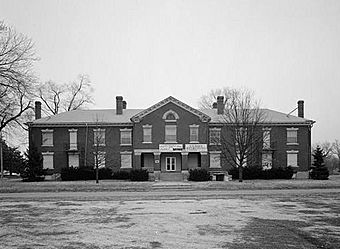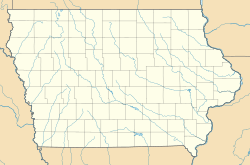Fort Des Moines Provisional Army Officer Training School facts for kids
|
Fort Des Moines Provisional Army Officer Training School
|
|

Bachelor Officers Quarters
|
|
| Location | Army Post Road, Des Moines, Iowa |
|---|---|
| Area | 204 acres (83 ha) |
| Built | 1903 |
| NRHP reference No. | 74000805 |
Quick facts for kids Significant dates |
|
| Added to NRHP | May 30, 1974 |
| Designated NHLD | May 30, 1974 |
The Fort Des Moines Provisional Army Officer Training School was an important military base in Des Moines, Iowa. It was started in 1901. This fort was special because it trained African American officers for the U.S. Army during World War I. Later, in 1942, it became the first place where women trained for U.S. Army service. This was part of the Women's Army Corps. Because of its important history, the older parts of the base were named a National Historic Landmark in 1974. The city of Des Moines took over the fort property in the 1950s. Today, different parts of the fort are used for public and private activities.
Contents
History of Fort Des Moines
There have been three forts named Fort Des Moines. This one, the third, was built in 1901. It covered about 640 acres, which is a very large area. At that time, it was outside the city of Des Moines.
The fort was first meant for cavalry, which are soldiers who fight on horseback. Construction began in 1903. They built barracks for soldiers, stables for horses, and homes for officers.
In 1917, something very important happened. The first group of African American officer candidates in U.S. military history trained here. They became officers after their training. Also in 1917, a training camp for Black medical staff started at the fort. In 1918, the fort helped treat soldiers injured in World War I.
In the 1920s and early 1930s, the fort housed military units again. These included both cavalry and artillery units. From 1933 to 1934, it was used as a camp for the Civilian Conservation Corps. This was a program that helped young men find work during the Great Depression.
When the United States entered World War II, Fort Des Moines became a training center for women. These women joined the Army's Women's Army Corps. After the war, the fort housed veteran soldiers for a while. In the early 1950s, the city took over most of the fort. However, a part of the old grounds became a U.S. Army Reserve training center in 1949. It is still used for this purpose today.
Training the First Black Officers
In 1916, people were debating if all Americans should serve in the military. Some political leaders did not want Black Americans to serve. However, their efforts to stop Black Americans from serving failed. The National Defense Act of 1916 still made it hard for Black Americans to become officers.
Joel E. Spingarn, who led the NAACP, worked to create a separate training program for Black officers. He learned that the U.S. Army and the government did not want different races to train together. General Leonard Wood also helped push for a separate officers' camp. General Wood agreed to organize a summer camp if Spingarn could find 250 applicants.
In February 1917, Spingarn wrote a letter asking the Black community to support a separate camp. People had different opinions. Some groups did not like the idea of a segregated camp. But many college leaders, professors, and students supported it. George W Cook of Howard University was a big supporter. Leaders from other Black colleges also backed the plan.
Many of the first applicants were members of college fraternities. George E. Brice, a student leader at Howard University, helped recruit from fraternities. These groups spread the word to get support for the training program. Many applicants hoped that military service would help them gain equality with white Americans. By March 31, 1917, Spingarn had enough applications. He believed the camp would move forward.
One week later, the United States declared war on Germany. This put the training program at risk. The NAACP worked even harder to fight for the camp. They, along with many college officials and students, spoke to members of Congress and officials in the War Department.
On April 28, 1917, Spingarn stepped down from the NAACP to begin his own military training. Roy Nash, the NAACP Executive Secretary, took over the fight for the camp. Spingarn wrote to George Brice, saying he was hopeful that if Black people worked together, they would get officer training.
Brice replied, "We realize we will have to sacrifice our education. But we hope serving our country and our race will pay us back for the time lost."
A group called the Central Committee of Negro College Men worked to appeal to Congress and the War Department. Finally, on May 12, Secretary of War Newton D. Baker announced that a training camp for Black men would be created. On May 19, 1917, the War Department said the three-month camp would be at Fort Des Moines, Iowa.
How the Camp Operated
On June 17, 1917, 1,250 trainees arrived at the camp. They learned about "trench warfare, infantry drill, and physical training." They also learned about equipment care, bayonet use, and signaling. Their daily schedule was very long, from 5:45 A.M. to 9:45 P.M. The officer trainees were paid $100 each month.
Fort Des Moines also trained Black medical personnel at the same time. This 5-month course produced 104 medical officers and 12 dental officers. It also trained 948 enlisted men.
Colonel Charles C. Ballou, a white officer, ran the camp. Many in the Black community had hoped that Lieutenant Colonel Charles Young, a Black officer, would be chosen.
Colonel Ballou told his trainees how important their success was. He said, "Your race will be on trial with you as its representatives." Colonel Ballou had experience leading Black troops before. He was later replaced by Lieutenant Colonel Henry Hunt when Ballou was promoted.
The ceremony where the trainees became officers was set for September. It was moved to October 10th. On that day, "Six hundred twenty-nine men earned commissions." They became captains, first lieutenants, and second lieutenants in the National Army.
After a two-week break, these new officers went to seven different army camps. They trained Black soldiers in various units. All these units later went to fight in France as the 92nd Division. Charles Ballou, who had been promoted to Major General, led the 92nd Division in France.
Fort Des Moines Today
Much of the original 640-acre base was sold off as Des Moines grew. The main part of the base that still exists is around the old parade ground. Today, parts of the former base are used for the Blank Park Zoo. An apartment complex has also been built on part of the parade ground.
However, many of the fort's original buildings are still standing. These are mostly on the southern and eastern sides of the parade ground. These buildings include barracks, officers' quarters, and stables. They are now used for different community and business purposes. These remaining parts of the fort were named a National Historic Landmark in 1974. This was to honor their important role in helping African Americans and women advance in the U.S. military.
The Fort Des Moines Museum and Education Center celebrates this history. It honors the first officer candidate class for African American men in 1917. It also remembers the start of the first Women's Army Auxiliary Corps (WAACs) in 1942.
See also




